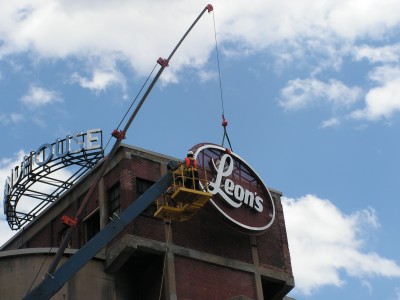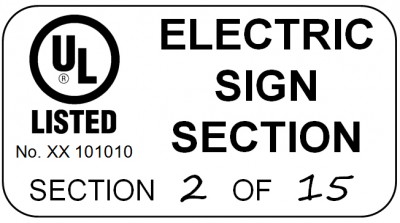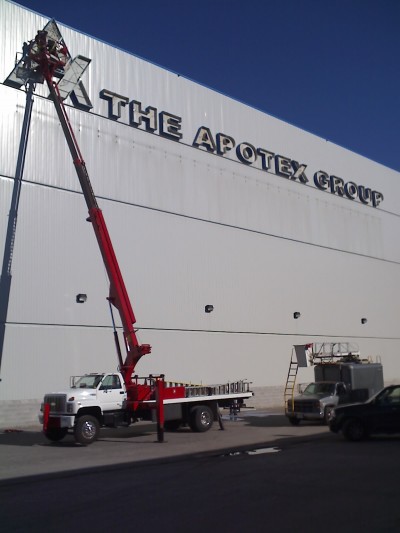Markings and installation instructions
by all | 7 February 2014 8:30 am
 [1]
[1]File photos
By Jeffrey A. Fecteau
Electrical codes require that specific markings and installation instructions be displayed for electric signs, with visible labelling on their faces. In fact, code authorities actively check signs to verify all of the required markings are present, so signmakers need to know how to prepare their projects accordingly.
Requirements for listed signs
Article 600 of the National Electrical Code (NEC), Electric Signs and Outline Lighting, and Section 34 of the Canadian Standards Association’s (CSA’s) Canadian Electrical Code (CEC), Signs and Outline Lighting, both cover the installation of conductors, equipment and field wiring for all types of electric signs, regardless of their voltage.
Further, Section 600.3 of NEC states signs are to be listed by a Nationally Recognized Testing Laboratory (NRTL), such as Underwriters Laboratories (UL), and installed in conformance with that listing. Similarly, CEC’s Rule 2-2024, Use of Approved Equipment, mandates that all equipment be certified for use.
The main UL product safety category for signs, UXYT (UXYT7 in Canada), covers electrical signs that use incandescent lamps, light-emitting diodes (LEDs), electroluminescent (EL) panels, fluorescent lamps, neon tubing, high-intensity discharge (HID) lamps or any combination thereof, with installations carried out in accordance with NEC’s Section 34.
In addition to the rules for listing and labelling, signs are required to comply with NEC Section 600.4 or CEC Rule 2-100, Marking of Equipment, which outlines specific marking requirements and some permissive labelling applications.
The marking labels are to be durable and permanent. When signs are installed in wet locations, the labels need to be weatherproof as per NEC Section 600.4(D) and CEC Rule 2-100. Under CEC, ‘permanent’ marking implies indoor, outdoor, wet and dry durability.
Marking labels attached to UL-listed signs have been evaluated for their adhesion, permanence, legibility and exposure to the applicable environmental conditions. They are intended to be used by sign manufacturers, for application to their own products, at their place of production.
If a sign has either a neon transformer or an electronic power supply that is equipped with secondary-circuit ground-fault protection (SGFP), then that too is required to be marked as such, under NEC Section 600.23(F) and CEC Rule 34-302, Secondary-circuit Ground-fault Protection. All of the neon transformers and electronic power supplies that comply with this marking requirement are covered by another UL product category, PWIK (PWIK7 in Canada).
 [2]
[2]Listed labels are required under NEC Section 600.3.
How to comply
Signs that have been evaluated to UL 48, Electric Signs, face requirements for marking and installation instructions. All of the sign markings are to be visible during installation and available after installation. For category UYXT7 in Canada, the standard is CSA C22.2 No. 207-M89, Portable and Stationary Electric Signs and Displays.
Signs intended for indoor use are marked for ‘dry locations only.’ Those intended for installation in potentially damp locations are marked as ‘suitable for damp locations,’ while those intended for wet locations are marked as ‘suitable for wet locations.’
LED-illuminated signs installed in wet locations where their Class 2 cables do not have a moisture-impervious metal sheath need to be identified, as per NEC Section 600.33(A)(1) and CEC Rule 16-210, Conductors for Class 2 Circuit Wiring, for use in wet locations. Class 2 cables that are suitable for such locations are marked with ‘wet’ or ‘wet location.’ (It is worth noting the 2012 edition of CEC does not yet include specific rules for LED-illuminated signs, so the wiring methods in its general sections will apply.)
NEC Section 600.33 requires that LED-based signs are to be installed in accordance with the sign manufacturer’s instructions. It also requires that the cable installed on the load side of the Class 2 power source must be a listed Class 2 cable that meets the relevant requirements for Class 2 circuits, as contained in Part III of NEC’s Article 725 and in CEC’s Section 16, Class 1 and Class 2 Circuits. The UL product category for power-limited circuit cables, QPTZ (note: there is no such category for Canada), covers such cables intended for use in Class 2 circuits, as described in NEC’s Article 725 and CEC’s Section 16.
Both UL 48 and NEC Section 600.4(A) require signs to be marked with the manufacturer’s name, trade name, trademark or identifier, along with electrical ratings in both volts (V) and amps (A). The aforementioned CSA C22.2 No. 207-M89 and Rule 2-100 are not identical to their U.S. counterparts, but are used for the Canadian categories and do also require the manufacturer’s name in the markings.
 [3]
[3]All markings for electric signs are to be visible during installation and available afterwards.
All permanently connected signs are to include their installation instructions, including mounting details and wiring methods. These instructions may be provided in the form of drawings and/or diagrams. They are to be marked on, attached to or shipped with the sign, so they are available throughout installation and setup.
Electrical signs of very large size, such that it would be impractical to ship them in one carton or full assembled, are permitted to be divided into sections. Each major subassembly needs to bear an ‘electric sign section’ listing mark.
Sign section subassemblies are to be marked where readily visible during installation and to identify the following:
- Splice enclosure.
- Conductors to be spliced.
- Voltage rating of the splice insulation.
- Section number.
Also, for all section signs, the following marking is required to be provided, in accordance with NEC Section 600.4(E): “Installation and assembly required; see installation instructions.” While CEC does not contain the same requirements, Rule 2-100 refers to “other markings necessary to ensure safe and proper operation.”
As suggested, the section sign installation instructions are to be either attached to each subassembly or shipped with the sign. The instructions must contain the following:
- A drawing depicting the arrangement of the subassemblies.
- Written instructions for the physical installation of the subassemblies and the mechanical connections between them.
- A drawing depicting the wiring arrangement of the subassemblies and the components necessary to complete the electrical connections between them.
- Any conditions of use required for the subassemblies.
- Any conditions of use for components required to complete the wiring.
- Written instructions for the field wiring between the subassemblies and any components.
- The specified connection to the source of the electrical supply.
- The requirements for grounding and bonding the sign.
Prepare for inspection
So, NEC Article 600, UL 48, CEC Section 34 and CSA-C22.2 No. 207-M89 all identify specific sign marking requirements, as well as the requirement for including installation instructions. Code authorities are tasked with verifying all of the required markings are present and reviewing each sign’s installation instructions, as part of their inspection process.
Jeffrey A. Fecteau is lead regulatory engineer for Underwriters Laboratories (UL), which tests and certifies products for safety. For more information, contact him via e-mail at jeffrey.fecteau@ul.com[4] or visit www.ul.com[5].
- [Image]: http://www.signmedia.ca/wp-content/uploads/2014/02/L-34.jpg
- [Image]: http://www.signmedia.ca/wp-content/uploads/2014/02/ul_listing-copy.jpg
- [Image]: http://www.signmedia.ca/wp-content/uploads/2014/02/19-10-08_1038.jpg
- jeffrey.fecteau@ul.com: mailto:%20jeffrey.fecteau@ul.com
- www.ul.com: http://www.ul.com
Source URL: https://www.signmedia.ca/markings-and-installation-instructions/